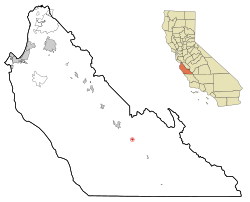Demographics
Historical population| Census | Pop. | Note | %± |
|---|
| 2000 | 419 | | — |
|---|
| 2010 | 269 | | −35.8% |
|---|
| 2020 | 324 | | 20.4% |
|---|
|
San Lucas first appeared as a census designated place in the 2000 U.S. census. [24]
2020
The 2020 United States census reported that San Lucas had a population of 324. The population density was 822.3 inhabitants per square mile (317.5/km2). The racial makeup of San Lucas was 139 (42.9%) White, 1 (0.3%) African American, 3 (0.9%) Native American, 1 (0.3%) Asian, 2 (0.6%) Pacific Islander, 137 (42.3%) from other races, and 41 (12.7%) from two or more races. Hispanic or Latino of any race were 302 persons (93.2%). [26]
The whole population lived in households. There were 76 households, out of which 39 (51.3%) had children under the age of 18 living in them, 45 (59.2%) were married-couple households, 10 (13.2%) were cohabiting couple households, 14 (18.4%) had a female householder with no partner present, and 7 (9.2%) had a male householder with no partner present. 8 households (10.5%) were one person, and 2 (2.6%) were one person aged 65 or older. The average household size was 4.26. [26] There were 67 families (88.2% of all households). [27]
The age distribution was 112 people (34.6%) under the age of 18, 31 people (9.6%) aged 18 to 24, 92 people (28.4%) aged 25 to 44, 60 people (18.5%) aged 45 to 64, and 29 people (9.0%) who were 65 years of age or older. The median age was 28.8 years. For every 100 females, there were 100.0 males. [26]
There were 76 housing units at an average density of 192.9 units per square mile (74.5 units/km2), which were all occupied, 27 (35.5%) by homeowners and 49 (64.5%) by renters. [26]
2010
The 2010 United States census [28] reported that San Lucas had a population of 269. The population density was 682.5 inhabitants per square mile (263.5/km2). The racial makeup of San Lucas was 113 (42.0%) White, 0 (0.0%) African American, 4 (1.5%) Native American, 6 (2.2%) Asian, 0 (0.0%) Pacific Islander, 127 (47.2%) from other races, and 19 (7.1%) from two or more races. Hispanic or Latino of any race were 224 persons (83.3%).
The Census reported that 269 people (100% of the population) lived in households, 0 (0%) lived in non-institutionalized group quarters, and 0 (0%) were institutionalized.
There were 67 households, out of which 38 (56.7%) had children under the age of 18 living in them, 46 (68.7%) were opposite-sex married couples living together, 8 (11.9%) had a female householder with no husband present, 3 (4.5%) had a male householder with no wife present. There were 4 (6.0%) unmarried opposite-sex partnerships, and 0 (0%) same-sex married couples or partnerships. 7 households (10.4%) were made up of individuals, and 2 (3.0%) had someone living alone who was 65 years of age or older. The average household size was 4.01. There were 57 families (85.1% of all households); the average family size was 4.23.
The population was spread out, with 87 people (32.3%) under the age of 18, 38 people (14.1%) aged 18 to 24, 74 people (27.5%) aged 25 to 44, 58 people (21.6%) aged 45 to 64, and 12 people (4.5%) who were 65 years of age or older. The median age was 26.3 years. For every 100 females, there were 110.2 males. For every 100 females age 18 and over, there were 111.6 males.
There were 76 housing units at an average density of 192.8 per square mile (74.4/km2), of which 36 (53.7%) were owner-occupied, and 31 (46.3%) were occupied by renters. The homeowner vacancy rate was 0%; the rental vacancy rate was 11.4%. 132 people (49.1% of the population) lived in owner-occupied housing units and 137 people (50.9%) lived in rental housing units.
2000
As of the census [29] of 2000, the median income for a household in the CDP was $31,538, and the median income for a family was $30,536. Males had a median income of $27,000 versus $24,375 for females. The per capita income for the CDP was $7,834. About 23.3% of families and 29.7% of the population were below the poverty line, including 38.2% of those under age 18 and 11.4% of those age 65 or over.
This page is based on this
Wikipedia article Text is available under the
CC BY-SA 4.0 license; additional terms may apply.
Images, videos and audio are available under their respective licenses.


